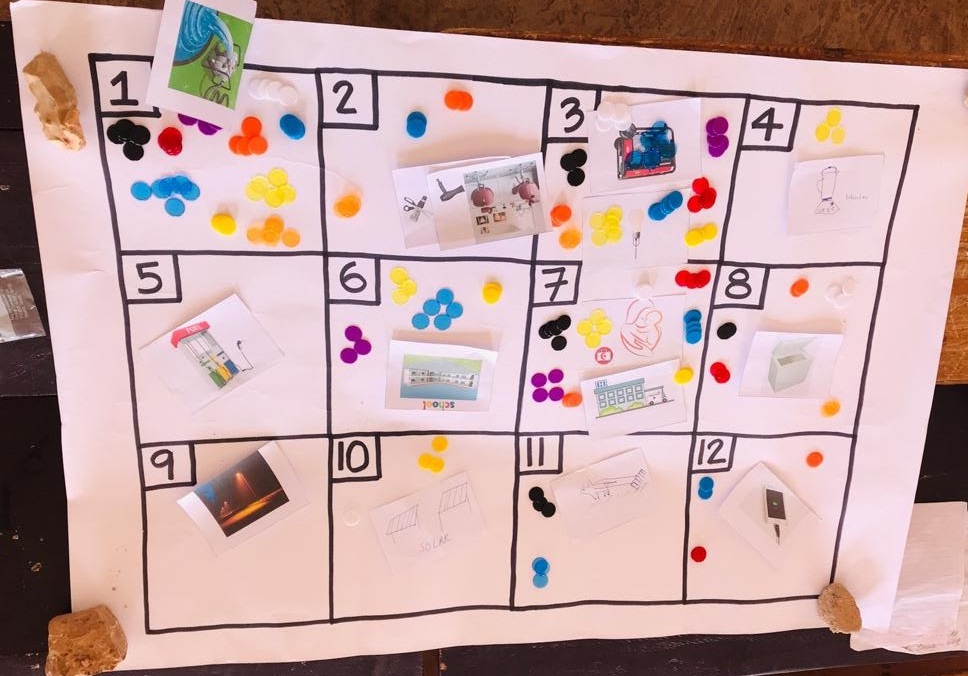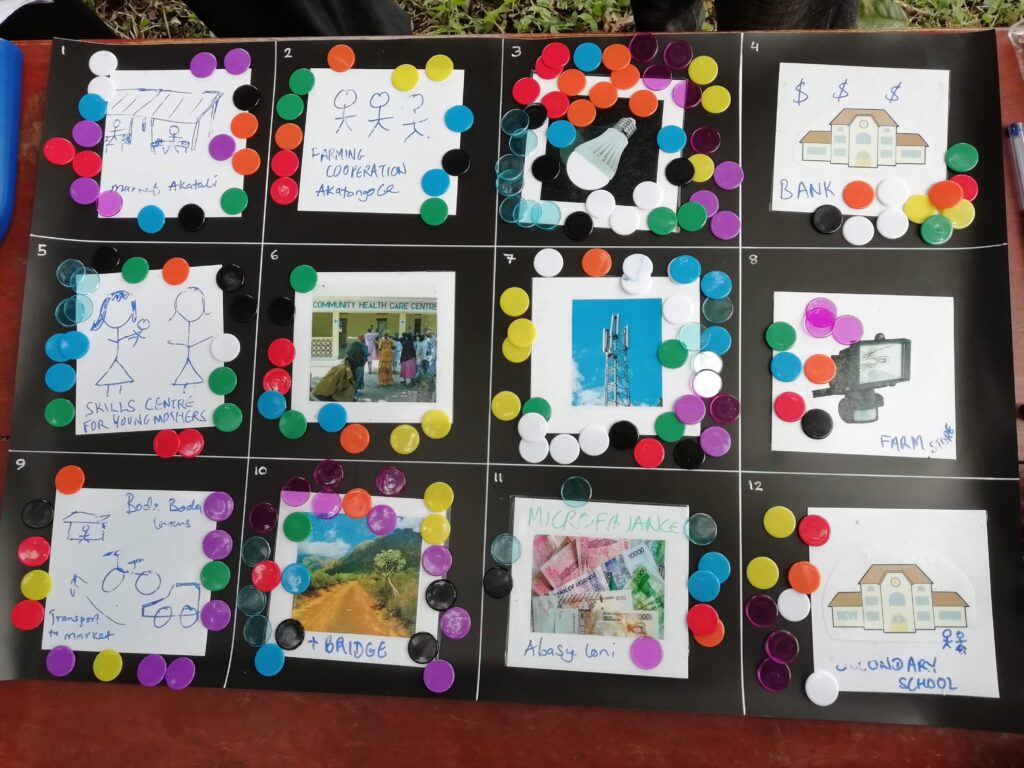As part of our project with Clear Sky Power and Energy Action Partners in Somaliland, we ran Service Value Tests (more here) in the three focus communities for the project. The aim was to help us get to know them a bit better, understand their needs and priorities, and so design the COMET toolkit to be appropriate for simulating the operation of a minigrid for the Somaliland context. In this post we dive into the results for Qool-Caday, a small community of 47 households and 36 businesses just South of Hargeisa.
Three focus groups were run with groups of men, women and youth. During the focus groups, participants were asked what services they needed in their village in the future, the suggestions were collated, and then participants expressed their preferences through distributing counters across the services. The quantitative preference results, along with the discussions following the exercise which dove into the ‘why’ of participants’ choices and the surrounding context, give us really useful insight into the future development priorities of Qool-Caday from the perspective of those that live there (arguably, the most important perspective that development projects should be listening to).

The bar chart below shows the popularity data, combined across all 3 groups, for Qool-Caday, and next to it is the Service Map, which maps the services according to how easy they would be to deliver (from a technical, logistics, and economic perspective) and the near-term economic benefit they might offer the community. The preference data is still there in the size and colour of the bubbles.
What do these charts tell us? Firstly, from the popularity chart we can see that access to services that meet basic human rights are the highest priority for participants. This includes better access to water, improved education facilities, and health services. This suggests, and surveys and further conversations corroborated this, that there is currently a significant deficit in these basic needs being met. Understandably, this is a core concern for the community. Electricity and lighting for households is also of high priority across the groups.
Then there is a group of services which can be termed income-generating services – services which people have identified that would enable them to make some money and thus improve their economic situation. This includes agricultural tools, fridges, livestock, salons. The position of these services as secondary in importance to the basic services of health, water and education, show that after those basic needs are met, this community has many ideas and insights into the opportunities around them through which they could generate income. Skills centre is also present, showing the desire to learn vocational skills that could improve livelihoods, and during the discussion, developing tailoring and welding skills were linked to this.
That’s the popularity data – now the Service Map tells us a bit about how community preferences trade off with two other design decision criteria. One is Ease of Delivery, which encompasses the technical challenge of delivering the service, the infrastructure required, and any complexity of having to integrate into pre-existing systems (such as integrating into a national health system for a health centre, or acquiring trained personnel). The second ranks services according to the Near-term Economic Benefit to the community which they might have.
Focusing on the two groups of services: basic human needs services and income-generating services; the map broadly splits these. Services meeting basic human needs are roughly less easy to deliver, and have less economic benefit in the near term, whereas the income-generating services perform generally better for both criteria – easier to put on the ground and, intuitively, provide opportunity for business. They are clustered around the green area where both decision criteria are optimised. Of course, this doesn’t mean that the design of an energy system should neglect those services that meet basic human needs, but which don’t do so well on these two axes – the function of the map is simply to illuminate trade-offs, and doesn’t make any statement as to what should be included or not. It is up to the user to carefully interpret the map and come up with a design. Clearly, the services around education, water, and health are really important to community members, and if a criterion was used which captured health and wellbeing, they would rank very highly.
You might notice that the service electricity has not made it on to the Service Map. We discuss in another post why the suggestion of electricity as a service, without an expansion into why electricity is needed, is tricky under this method.
Actually implementing the community energy system and associated services is not within the scope of this current project, but we are really excited about the possibility of continuing to work with Qool-Caday in the future to carry this out and meet some of their needs and priorities. If we were scoping the design of an energy system from these results (and of course, we would need to conduct checks to make sure this data is up to date when the time comes), we’d recommend the following approach:
The basic human needs services are clearly really crucial and the energy project should include provision to enable these where possible. SVRG has experience with solar water pumping, so this would be a key service to explore, as well as providing electricity for the school which would benefit current students, and also provide opportunity for night-classes for adults – something discussed during the focus groups. Actually building, staffing, and operating a health clinic will be outside of the scope of activities possible for the project consortium, though knowing it is of such high priority to the community, we could pursue advocacy and seek other avenues of funding, and support the community in building one for themselves. Once it’s built, it is relatively simple to extend an electricity connection to it so it can have adequate lighting for procedures, and the machines for medical tests that are required for diagnosis.
We would have to be cognisant of the high power demand of the water pump, but this could also act as an anchor load for the system, and by selling the water at a moderate price, it enables a steady revenue stream for the village cooperative, or other entity, running the energy system. The project could then look to size a system, and develop the capacity of the community members, to support the income-generating services that will provide a near-term economic benefit to the community. Salons, lighting for shops, fridges, phone charging, and tailoring businesses will have feasible power requirements, and enable growth of Qool-Caday’s small commercial centre.
In this way, through the use of COMET and further consultation with the community, we would build up demand profiles, and then a system design which met community needs, but which was carefully scoped to be financially viable both in terms of cost of use for community members, but also for project developers.



